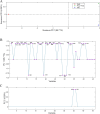Evaluation of the Chemical Profile by Paper Spray Mass Spectrometry of Eugenia uniflora Pulp, Peel, Seeds, and Jelly
- PMID: 40955461
- PMCID: PMC12439022
- DOI: 10.1002/jms.5173
Evaluation of the Chemical Profile by Paper Spray Mass Spectrometry of Eugenia uniflora Pulp, Peel, Seeds, and Jelly
Abstract
Pitangueira (Eugenia uniflora) is a fruit tree found in the Cerrado, Caatinga, and Atlantic Forest Brazilian biomes. Due to its intense and characteristic aroma and flavor, its fruits (Brazilian cherry) can be consumed raw and as an ingredient in jellies, giving it better use and a more excellent shelf life. The objective of this work was to evaluate the chemical profile of chemical compounds in the pulp, peel, seed, and jelly prepared with the pulp and peel of Brazilian cherry. The characterization of the chemical profile was performed by a fast and simple method: paper spray ionization method coupled with mass spectrometry in positive and negative ionization modes. Forty-six compounds were tentatively identified in the negative mode and 15 in the positive mode, belonging to the classes of phenolic acids, organic acids, fatty acids, hydroxycinnamic acids, sugars, betalains, carotenoids, flavonoids, and tannins. Characterizing these native Brazilian fruits and their products may increase interest in their use, highlighting the potential of Brazilian cherry as a source of nutrients and bioactive compounds. Therefore, developing technological processes for better use and conservation of fruits and, at the same time, identifying the phytochemical compounds present in the product is a way of valuing and preserving our Brazilian biodiversity.
Keywords: Brazilian cherry; conservation; fingerprints; phytochemicals.
© 2025 The Author(s). Journal of Mass Spectrometry published by John Wiley & Sons Ltd.
Conflict of interest statement
The authors declare no conflicts of interest.
Figures





References
-
- Takahashi J. A., Melo J. O. F., Araújo R. L. B., et al., “Economic, Nutritional, and Innovative Aspects of Non‐Conventional Brazilian Fruits in the International Novel Foods Market,” Food Research International 1 (2024): 115223–115239. - PubMed
-
- Fidelis E. M., Savall A. S. P., Pereira F. O., Quines C. B., Ávila D. S., and Pinton S., “Pitanga (<styled-content style="fixed-case"> Eugenia uniflora </styled-content> L.) as a Source of Bioactive Compounds for Health Benefits: A Review,” Arabian Journal of Chemistry 15 (2022): 103691.
-
- Migues I., Baenas N., Gironés‐Vilaplana A., Cesio M. V., Heinzen H., and Moreno D. A., “Phenolic Profiling and Antioxidant Capacity of <styled-content style="fixed-case"> Eugenia uniflora </styled-content> L. (Pitanga) Samples Collected in Different Uruguayan Locations,” Foods 7 (2018): 67. - PMC - PubMed
-
- Ramalho R. R. F., Barbosa J. M. G., Ferri P. H., and Santos S. C., “Variability of Polyphenols and Volatiles During Fruit Development of Three Pitanga (<styled-content style="fixed-case"> Eugenia uniflora </styled-content> L.) Biotypes,” Food Research International 119 (2019): 850–856. - PubMed
-
- Cipriano P. A., Ekici L., Barnes R. C., Gomes C., and Talcott S. T., “Pre‐Heating and Polyphenol Oxidase Inhibition Impact on Extraction of Purple Sweet Potato Anthocyanins,” Food Chemistry 180 (2015): 227–234. - PubMed
MeSH terms
Substances
Grants and funding
- APQ-04336-23/Fundação de Amparo à Pesquisa do Estado de Minas Gerais
- APQ-05883-24/Fundação de Amparo à Pesquisa do Estado de Minas Gerais
- PPE-00094-23/Fundação de Amparo à Pesquisa do Estado de Minas Gerais
- 5.308/15/Fundação de Amparo à Pesquisa do Estado de Minas Gerais
- 132217/2023-6/Conselho Nacional de Desenvolvimento Científico e Tecnológico
LinkOut - more resources
Full Text Sources

